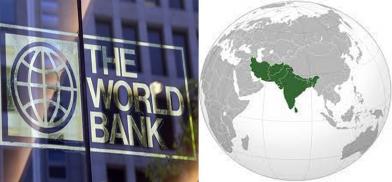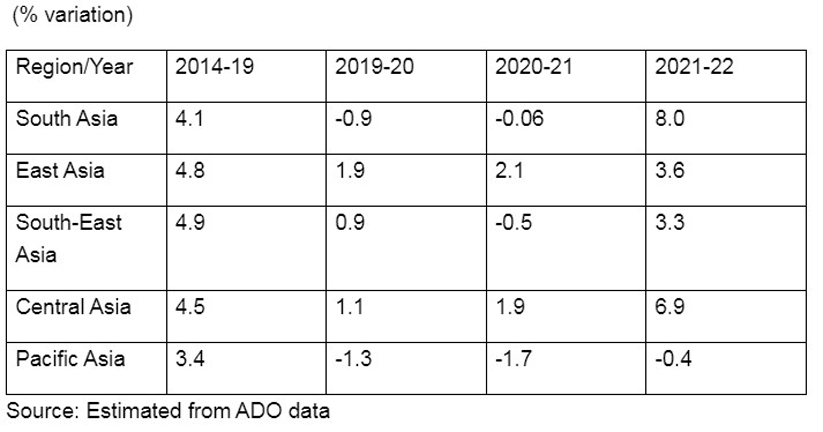South Asia: Differential growth rates calls for enhanced intra-regional cooperation
One of the impacts of the pandemic in South Asia has been on education. Yet, at least 11 million primary-age and almost 21 million lower secondary-age children in South Asia are not even in school, according to a recent UIS estimate.

The Asian Development Outlook(ADO) published by the Asian Development Bank brings out data on GDP for its member countries including countries of South Asia along with countries of other regions of Asia- Central Asia. East Asia, South East Asia and Pacific Asia. We have tried to see the trends in GDP growth from 2014 till about 2021-22. The idea has been to see how the COVID pandemic has disrupted the long-term growth trends and left permanent scars on the countries of the region affecting their recovery process.
We begin by presenting estimates of average growth rates of the various regions of Asia based on the ADO

The South Asia region saw the maximum variation in growth rates followed by Central Asia, South East Asia, Pacific Asia and East Asia. The average growth rates have tended to become unrepresentative of the growth rates for every country within the region particularly after the onset of the COVID-19 pandemic. implying that countries differed in their impact depending on their ability to cope with the pandemic through counter-cyclical fiscal and monetary measures. Statistical estimates of the International labour Organisation show that the impact is greater in countries where there is more informality, nonstandard employment and a female workforce. The South Asia region has all three socio-economic characteristics that have been affected by COVID-19.
South Asia is home to approximately one-sixth of the global population. Across South Asia, most of the workforce is classified from extremely poor to near poor. Estimates show that 69% of the workforce in Bangladesh, 73% in India, 63% in Nepal, 75% in Pakistan and 30% in Sri Lanka fall within one of these poverty categories. Although workers in different countries across the sub-region face difficult challenges, their conditions are often characterized by a common thread of informality, working modalities that strip access to rights or social protection, labour rights abuses, and risk of losing their job or income due to, for instance, climate change and the changing world of work[i]
Growth variation
Our estimates also show that the variation in the intra-regional growth rates has been higher in South Asia as compared to other intra-regional growth rates within different regions of Asia. It shows not only the differential impact between countries of the region during the COVID-19 pandemic but also in the recovery period. The difference in the growth rates between counties which experienced the highest and the lowest growth rates which is estimated to be 4.8% during 2014-19 increased to 19.2% in 2019-20 and further to 25.7% in 2021-22. It only shows the widening difference between the country with the highest growth rate and the one with the lowest which shows that COVID-19 has affected some countries much more severely than some others leaving its scars even in the recovery period with the differentials widening even further. This trend has also been confirmed by the estimates of standard deviation which is a measure of the dispersion of the data from the average or the mean. The standard deviation estimates for South Asia have increased from 2.16 in the 2014-19 period to 5.62 in 2019-20 and further to 9.31 in 2021-22. The variation in the standard deviation estimates has been far lower in other parts of Asia except Pacific Asia which saw a sharp increase in one year during the recovery period.It shows that the mean growth rate for most regions of Asia has been fairly representative of the actual growth rate within the region . The exception has been South Asia where the estimates of standard deviation show that the average growth rate for the region is not a representative one with intraregional data showing wide variations. Such variations only go on to show the differential impact of the COVID-19 pandemic and the post-pandemic recovery that it has had on the growth rates of the region.
Projections for South Asia
Gross domestic product in South Asia grew by an estimated 5.3 per cent in 2023 and is projected to increase by 5.2 per cent in 2024, driven by a robust expansion in India
Growth in India is projected to remain strong at 6.5 percent in both 2024 and 2025, with an upgrade from October of 0.2 percentage points for both years, reflecting resilience in domestic demand. as the effects of the shock to energy [ii]
To boost longer-term growth, structural reforms are needed to accelerate investment, improve productivity growth, and close gender gaps in labor markets[iii]
Some promising areas of cooperation in South
Asia:
1. Energy cooperation is moving ahead. Recently by way of steps towards a regional electricity market, India opened doors to the neighboring countries including Bangladesh, Bhutan, and Nepal to buy and sell power in the real-time energy market via the India Energy Exchange. This allows countries to trade electricity closer to real-time as and when available and required. Nepal is the first South Asian country to participate, where it can sell 44 MW of power in real-time. India and Nepal also agreed on a long-term plan to purchase 10,000 MW of power from Nepal in the next 10 years. Other developments include the momentum of the India-Sri Lanka interconnector—which will link the national grids of India and Sri Lanka. Once operational, the interconnector will open opportunities for market-based trading between India and Sri Lanka as well as the rest of the region. A regional electricity market will increase synergies among clean energy resources, allow the region to tap its immense hydropower potential, especially in Nepal and Bhutan, and ensure low-cost energy access in South Asia. Estimated by World Bank to lead to a 4.5% reduction of CO2 emissions by 2035, and potentially yield up to $17.4 billion in cumulative economic benefits in 2023-2035.
2. Regional trade and connectivity. The Akhaura -Agartala rail link between India’s northeastern state Tripura and Bangladesh was inaugurated this year, and Bangladesh gave India access to its Chattogram and Mongla ports for transit and cargo vessels, pushing regional connectivity in the Bay of Bengal area. India and Sri Lanka also revived their ferry service after 40 years. India and Nepal renewed the Treaty of Transit, giving Nepal access to India’s inland waterways and agreements for new rail links. India and Bhutan also agreed to bolster regional connectivity with a focus on the first-ever rail link between Assam and Bhutan, and on upgrading border post infrastructure. Bangladesh and Bhutan signed a transit agreement enabling Bhutan to use Bangladesh’s roads, waterways, railways, airways, and seaports for its third-country trade. The World Bank Accelerating Transport and Trade Connectivity (ACCESS) program facilitates cross-border trade and connectivity with support to improved and modernized transport, border, and customs infrastructure, digital systems, and processes in the sub-region, with a focus on Bangladesh, Nepal and Bhutan.
3 Climate cooperation. South Asia’s climate vulnerability remains high and even this year, extreme climate events like floods and soaring temperatures continued to hit the region. There is a greater consensus on the need to work together on climate and environmental issues. In 2023 in partnership with the UK’s Foreign, Commonwealth, and Development Office, the Resilient Asia Program, was launched which is a $65 million program over the next eight years to accelerate transformational and collaborative climate action in South Asia, with an initial focus on air pollution management, disaster risk management, thermal cooling, biodiversity conservation in the Sundarbans, and transboundary water cooperation. Given the spatial interdependence of air pollution, The World Bank is working with the countries of the Indo-Gangetic Plain to foster collaborative action on air quality management.
4 Other areas of cooperation. These areas include venturing into new areas of cooperation including higher education and pandemic resilience and response. Among South Asian countries, cooperation in the areas of digital connectivity, digital infrastructure, and cross-border digital payments is moving fast.
One of the impacts of the pandemic in South Asia has been on education.SDG 4, the overarching education goal, demands universal and inclusive participation in quality education up to the secondary level by 2030. Yet, at least 11 million primary-age and almost 21 million lower secondary-age children in South Asia are not even in school, according to a recent UIS estimate. Civil society, nongovernmental organizations, and governments need to work together with a shared vision to improve education. Concerned educationists and scholars have suggested that the discussion of globalization issues must support the proposition that quality, equity, and inclusion in education are the critical themes in the exploration of objectives, strategies, and how these can be effectively pursued in educational development in South Asia. [v]
Other issues deserve the attention of the global community. Most important among them are energy and food security climate change and concessional international lending in the areas of green and sustainable technology. .Although a lot has been said concrete action in these areas must come forthwith if South Asia is to move ahead amidst several challenges that it faces on diverse fronts.
(The writer is a retired special secretary, Government of India, and a commentator on economic issues. Views are personal. He can be reached at ppmitra56@gmail.com)
[i] https://www.safbhr.com/conceptnote
[ii] 2024WORLD ECONOMIC OUTLOOK UPDATE, JANUARY 2024 4 International Monetary Fund | January)
[iii] Global Economic prospects,The World Bank Januuary 2024https://openknowledge.worldbank.org/server/api/core/bitstreams/7a21a380-5c54-4a8d-9c54-22180abb1adb/content)
[iv] Fruman Cecil,5 key takeaways on regional cooperation in South Asia in 2023
|DECEMBER 26, 2023
[v] B.Jamil ,et alImplications of Globalization and Economic Reforms for Education Systems in South Asia
· First Online: 29 August 2021
· 1415 Accesses
Part of the Global Education Systems book series (GES) https://link.springer.com/









Post a Comment